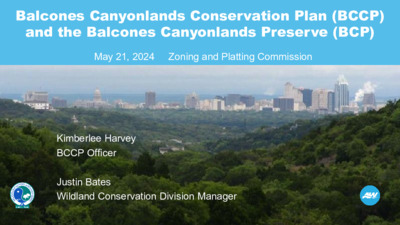20240521-004: Balcones Canyonlands Conservation Plan Staff Presentation — original pdf
Backup

Balcones Canyonlands Conservation Plan (BCCP) and the Balcones Canyonlands Preserve (BCP) May 21, 2024 Zoning and Platting Commission Kimberlee Harvey BCCP Officer Justin Bates Wildland Conservation Division Manager AGENDA BCCP Permit Overview BCCP Permit Updates BCP Conservation Commitments Analysis Land Management Challenges 2 KEY ELEMENTS OF BCCP PERMIT Provides eligible developers, landowners, and infrastructure providers with a streamlined approach to Endangered Species Act compliance for BCCP covered species in Travis County Allows and permits “take” of habitat and requires replacement acres protected within the Balcones Canyonlands Preserve (BCP) 3 KEY ELEMENTS OF BCCP PERMIT Permit Holders: City of Austin and Travis County Partners: City of Austin, Travis County, Lower Colorado River Authority, City of Sunset Valley, The Nature Conservancy, Travis Audubon, Texas Cave Management Association, USFWS, Balcones Canyonlands National Wildlife Refuge, and private preserve managers Permit Area: 561,000 acres = City of Austin and unincorporated Travis County excluding the Balcones Canyonlands National Wildlife Refuge boundary within Travis County Original Permit Term: 30 years (May 2, 1996 to May 2, 2026) • Applying for 15-year Permit extension (May 2, 2026 to May 2, 2041) 4 KEY ELEMENTS OF BCCP PERMIT Covered Species (35): • 7 endangered species: golden-cheeked warbler and six karst invertebrates • 1 de-listed species: black-capped vireo • 2 plants of concern: canyon mock-orange, texabama croton • 25 karst invertebrates of concern Covered Activities: • urban and rural development • road and utility construction, infrastructure 5 ORIGINAL BCCP REGULATORY DOCUMENTS Appendix A- Interlocal Cooperation Agreement Implementing the Balcones Canyonlands Conservation Plan- Shared Vision BCCP Habitat Conservation Plan and Final Environmental Impact Statement BCCP Federal U.S. Fish and Wildlife Endangered Species Take Permit City/County Cooperation Commitments Land Management and Habitat Mitigation Commitments Permit Conditions BALCONES CANYONLANDS CONSERVATION PLAN (BCCP) UPDATES • October 9, 2019: BCCP Coordinating Committee voted to recommend Permit extension and administrative updates to BCCP ILA and Habitat Conservation Plan. • October 2023: Austin City Council and Travis County Commissioner's Court voted to approve recommendations. • BCCP Permit Extension Application: 15-year Permit extension would extend the BCCP Permit expiration date to May 2, 2041 UPDATED BCCP ILA AND SHARED VISION EXECUTED IN 2023 Updated BCCP ILA: Accurately describe City and County Permit administrative duties Make clarifying edits to modernize the plan Industry standard language Change BCCP Secretary title to BCCP Officer KEY ELEMENTS OF BCCP MITIGATION OBLIGATIONS Acquire, protect in perpetuity, manage, and monitor a system of preserve lands called the “Balcones Canyonlands Preserve.” 28,428 acres of golden-cheeked warbler habitat 2,000 acres of black-capped vireo habitat Seven planning units called “macrosites” • Min. sizes and max. edge-to-area ratios Acquire and/or manage 35 named caves for listed karst invertebrates + 27 named caves for karst invertebrates of concern Protect and manage populations of canyon mock-orange and texabama croton on the BCP 32,428 acres bird habitat & 62 caves 9 BALCONES CANYONLANDS PRESERVE through FY-23 33,280 acres 62 BCCP PERMIT CAVES • 48 BCCP caves formally part of the BCP • 22 caves- City of Austin BCP • 15 caves- Travis County BCP • 8 caves- USFWS private protection • 2 caves- Texas Cave Management agreements Association • 1 cave-Texas Nature Conservancy • 4 private caves with development setbacks and/or management agreements • 10 caves unprotected BCCP MACROSITES Barton Creek Macrosite* North Lake Austin Macrosite Bull Creek Macrosite Pedernales River Macrosite* Cypress Creek South Lake Austin Macrosite Macrosite Devil’s Hollow Southwest Austin Macrosite Macrosite Lake Travis Macrosite West Austin Macrosite* POTENTIAL PRESERVE AREA Areas under consideration for BCP inclusion that had: • Habitat for species of concern • Areas potentially managed for species of concern • Intervening land considered necessary to maintain contiguity of preserve design MINIMUM PRESERVE DESIGN STANDARDS PHYSICAL CHARACTERISTICS HABITAT POTENTIAL Size in acres Width in feet Distance between preserves Ratio of preserve edge to overall area Distribution and occurrence of species of concern Presence of important karst habitat Long-term preserve viability Habitat quality expected with long-term management PRESERVE DESIGN STANDARDS ANALYSIS SUMMARY Minimum Acreage • 6 macrosites have exceeded minimum acreage • 1 macrosite 45 acres short of minimum acreage High Priority Key Macrosites • Exceeded combined minimum acreage by 5,882 acres Preserve Edge-to-area Ratio Maximum 20% • 3 macrosites have less than 20% edge-to-area • 1 macrosite just above ratio maximum at 21.7% • 1 macrosite ratio design standard unachievable COMMITMENT CONSTRAINTS • Landowners must be willing sellers. Texas State Law prohibits use of Eminent Opportunity Domain for preserve acquisition. • Pre-existing habitat fragmentation Economy & Population Growth • Land prices have increased. BCCP presumed annual population growth rate of 2.25% but actual annual average growth rate from 1996 – 2024 was 4.05% Regulatory Ecology • USFWS has issued individual incidental take permits within BCP preserve acquisition area since BCCP Permit was issued. • Not all caves remaining to protect have adequate land around them to protect features. Cave substitutions are necessary. MITIGATION OBLIGATIONS STRATEGY SUMMARY Pursue high priority sites as available Pursue remaining cave tracts Identify suitable karst substitution features Look for alternative sites with habitat and caves to compensate for lost lands and to improve the edge- to-area ratio. MANAGEMENT CHALLENGES URBAN EXPANSION • Small patch size/small populations • Habitat fragmentation/edge effects • Edge-adapted predators/parasites • Reduced hardwood recruitment (white-tailed deer, feral hogs, oak wilt) • Invasive, non-native plants MANAGEMENT CHALLENGES URBAN EXPANSION • Public access • Trespassing • Encampments • Fencing and boundary patrol • Habitat restoration • Water quality protection MANAGEMENT CHALLENGES PRESERVE MANAGEMENT • Species surveys • Oak wilt prevention & control • Non-native species removal • Climate change • Wildfire • Drought • Flooding Questions?